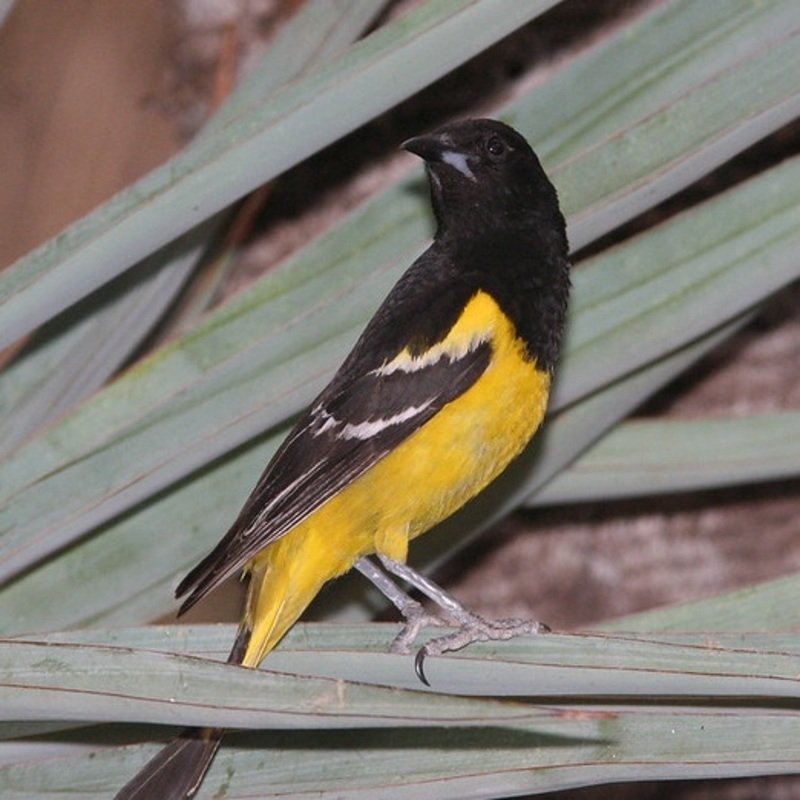The Scott’s oriole, Icterus parisorum (the same family as many blackbirds, meadowlarks, cowbirds, grackles, and others, including the New World orioles) it is found in the Southwest US, Baja California Sur, and central Mexico. It is very common from Sacramento south. Darius N. Couch named this bird after General Winfield Scott. The popular name was kept even after it was found that Bonaparte had described it.
Quick Overview: Icterus Parisorum – Scott’s Oriole
Body size: Around 7.5-9 in (19-23 cm) and a weight of 37 g (1.3 oz)
Main colors: Black, Lemon-yellow, White, Blue-gray, Gray
Range: Western portion of the United States
Migratory Bird: Yes
Best time of the year to see in the U.S.: June, July, August, September
Conservation Status: Least Concern
Scott’s Oriole Description
Spring and summer males have a black head and breast. The back, wings, and tail are all black. These birds have vivid lemon-yellow scapulars, posterior backs, bellies, rumps, shoulder patches, basal portions of the tail, under the tail, and wing coverts. Unlike other orioles, the Scott’s Oriole lacks orange. There is a white wing bar. Male bills are black with a bluish-gray upper base. Adult males in the winter have wider white wing patterns, gray back feathers, olive rump and upper tail coverts, and olive flanks. The young male’s head is mostly black by its first spring, but the female is only black when it is extremely old. A juvenile’s plumage develops over two years.

Size
These birds have a length of 7.5-9 in (19-23 cm) and a weight of 37 g (1.3 oz). Their wings could range from 10-13.5 in (25-34 cm).
Feeding
A grasshopper, a small beetle, a caterpillar, a butterfly, and insect larvae are among its favorite foods. It consumes cactus fruit and berries. Also probes flowers for nectar. This bird gleans insects from yucca blossoms. Ants, bees, and other insects feed on the nectar of this plant’s blossom. They feed on the nectar and insects drawn to the century plants and lechuguillas. The agave flowers also attract insects for this Oriole to eat.
Habitat
Scott’s Orioles are found in yucca gardens on desert grasslands and even on the hillsides of mountain valleys. Torrey and soaptree yuccas dominate. These orioles have been discovered in different small and large trees. They graze and sing in pines, oaks, and riparian regions within pine-oak habitats when not in yuccas. In the summer, they like live oak, Joshua, and yucca.
Behavior
This oriole is wary. It rarely leaves the woods, except to defend its territory from a Mexican or Blue Jay intruder. Its nest is so deep within a yucca that it is considered one of North America’s most secure birds. The adult males arrive first, then the females, and finally the juvenile males.
Icterus Parisorum Scientific Classification
- Kingdom: Animalia
- Phylum: Chordata
- Subphylum: Chelicerata
- Class: Aves
- Order: Passeriformes
- Family: Icteridae
- Genus: Icterus
- Species: Icterus parisorum
Best time of the year to see
The best time to see these birds in the United States is during the summer season (June – September).
Distribution of the Scott’s Oriole in the USA
Southern California, southern Nevada, Utah, Arizona, New Mexico, and western Texas, are all breeding grounds for this species. Winters primarily south of the United States-Mexico border.
